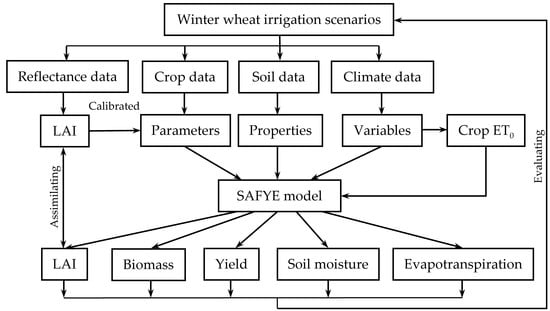Coupling Hyperspectral Remote Sensing Data with a Crop Model to Study Winter Wheat Water Demand
Abstract
:1. Introduction
2. Materials and Methods
2.1. Study Area
2.2. Experimental Design
2.3. Data Collection
2.3.1. Crop Data
2.3.2. Canopy Spectral Measurements
2.3.3. Soil Moisture
2.3.4. Meteorological Data
2.4. LAI Estimation from Canopy Spectral Reflectance
2.5. The SAFYE Model
2.6. Calibration of SAFYE Parameters
3. Results
3.1. Accuracy of LAI Estimation from Spectral Reflectance Data
3.2. Evaluation of the SAFYE Model Simulation
3.2.1. Leaf Area Index
3.2.2. Aboveground Biomass
3.2.3. Grain Yield
3.2.4. Soil Moisture
3.2.5. Crop Evapotranspiration
4. Discussion
5. Conclusions
Author Contributions
Funding
Acknowledgments
Conflicts of Interest
References
- Bai, J.J.; Yu, Y.; Di, L. Comparison between TVDI and CWSI for drought monitoring in the Guanzhong Plain, china. J. Integr Agric. 2017, 16, 389–397. [Google Scholar] [CrossRef]
- Vanuytrecht, E.; Raes, D.; Steduto, P.; Hsiao, T.C.; Fereres, E.; Heng, L.K.; Garcia Vila, M.; Mejias Moreno, P. Aquacrop: FAO’s crop water productivity and yield response model. Environ. Model. Softw. 2014, 62, 351–360. [Google Scholar] [CrossRef]
- Chen, F.; Cai, H.; Wang, J.; Ma, H. Estimation of evapotranspiration and crop coefficients of winter wheat and summer maize in Yangling zone. Trans. CSAE. 2006, 22, 191–193. [Google Scholar]
- Wang, W.; Feng, H. Water requirement and irrigation systems of winter wheat: CROPWAT-DSSAT model solution in Guanzhong district. Chin. J. Eco-Agric. 2012, 20, 795–802. [Google Scholar] [CrossRef]
- Huang, J.; Gomez-Dans, J.; Huang, H.; Ma, H.; Wu, Q.; Lewis, P.E.; Liang, S.; Chen, Z.; Xue, J.; Wu, Y.; et al. Assimilation of remote sensing into crop growth models: Current status and perspectives. Agric. For. Meteorol. 2019. [Google Scholar] [CrossRef]
- Ahmed, M.; Akram, M.N.; Asim, M.; Aslam, M.; Hassan, F.U.; Higgins, S.; Stöckle, C.O.; Hoogenboom, G. Calibration and validation of APSIM-wheat and CERES-wheat for spring wheat under rainfed conditions: Models evaluation and application. Comput. Electron. Agric. 2016, 123, 384–401. [Google Scholar] [CrossRef]
- Lu, C.; Fan, L. Winter wheat yield potentials and yield gaps in the north china plain. Field Crop. Res. 2013, 143, 98–105. [Google Scholar] [CrossRef]
- Araya, A.; Kisekka, I.; Gowda, P.H.; Prasad, P.V.V. Evaluation of water-limited cropping systems in a semi-arid climate using DSSAT-CSM. Agric. Syst. 2017, 150, 86–98. [Google Scholar] [CrossRef] [Green Version]
- Gaydon, D.S.; Balwinder, S.; Wang, E.; Poulton, P.L.; Ahmad, B.; Ahmed, F.; Akhter, S.; Ali, I.; Amarasingha, R.; Chaki, A.K.; et al. Evaluation of the APSIM model in cropping systems of Asia. Field Crop. Res. 2017, 204, 52–75. [Google Scholar] [CrossRef]
- Sansoulet, J.; Pattey, E.; Kröbel, R.; Grant, B.; Smith, W.; Jégo, G.; Desjardins, R.L.; Tremblay, N.; Tremblay, G. Comparing the performance of the STICS, DNDC, and DAYCENT models for predicting n uptake and biomass of spring wheat in eastern Canada. Field Crop. Res. 2014, 156, 135–150. [Google Scholar] [CrossRef]
- Dorigo, W.A.; Zurita-Milla, R.; de Wit, A.J.W.; Brazile, J.; Singh, R.; Schaepman, M.E. A review on reflective remote sensing and data assimilation techniques for enhanced agroecosystem modeling. Int. J. Appl. Earth Obs. Geoinf. 2007, 9, 165–193. [Google Scholar] [CrossRef]
- Wu, M.; Scholze, M.; Voßbeck, M.; Kaminski, T.; Hoffmann, G. Simultaneous assimilation of remotely sensed soil moisture and FAPAR for improving terrestrial carbon fluxes at multiple sites using CCDAS. Remote Sens. 2019, 11, 27. [Google Scholar] [CrossRef]
- Liu, J.; Pattey, E.; Jégo, G. Assessment of vegetation indices for regional crop green LAI estimation from Landsat images over multiple growing seasons. Remote Sens. Environ. 2012, 123, 347–358. [Google Scholar] [CrossRef]
- Parton, W.J.; Haxeltine, A.; Thornton, P.; Anne, R.; Hartman, M. Ecosystem sensitivity to land-surface models and leaf area index. Glob. Planet. Chang. 1996, 13, 89–98. [Google Scholar] [CrossRef]
- Maas, S.J. GRAMI: A crop growth model that can use remotely sensed information. ARS-US Dep. Agric. Agric. Res. Serv. (USA) 1992. [Google Scholar]
- Dong, T.; Liu, J.; Qian, B.; Zhao, T.; Jing, Q.; Geng, X.; Wang, J.; Huffman, T.; Shang, J. Estimating winter wheat biomass by assimilating leaf area index derived from fusion of Landsat-8 and MODIS data. Int. J. Appl. Earth Obs. Geoinf. 2016, 49, 63–74. [Google Scholar] [CrossRef]
- Casa, R.; Varella, H.; Buis, S.; Guérif, M.; De Solan, B.; Baret, F. Forcing a wheat crop model with LAI data to access agronomic variables: Evaluation of the impact of model and LAI uncertainties and comparison with an empirical approach. Eur. J. Agron. 2012, 37, 1–10. [Google Scholar] [CrossRef]
- Huang, J.; Tian, L.; Liang, S.; Ma, H.; Becker-Reshef, I.; Huang, Y.; Su, W.; Zhang, X.; Zhu, D.; Wu, W. Improving winter wheat yield estimation by assimilation of the leaf area index from Landsat tm and MODIS data into the WOFOST model. Agric. For. Meteorol. 2015, 204, 106–121. [Google Scholar] [CrossRef]
- Jégo, G.; Pattey, E.; Liu, J. Using leaf area index, retrieved from optical imagery, in the STICS crop model for predicting yield and biomass of field crops. Field Crop. Res. 2012, 131, 63–74. [Google Scholar] [CrossRef]
- Huang, J.; Ma, H.; Su, W.; Zhang, X.; Huang, Y.; Fan, J.; Wu, W. Jointly assimilating MODIS LAI and ET products into the swap model for winter wheat yield estimation. IEEE J. Sel. Top. Appl. Earth Obs. Remote Sens. 2015, 8, 4060–4071. [Google Scholar] [CrossRef]
- Huang, J.; Ma, H.; Tian, L.; Wang, P.; Liu, J. Comparison of remote sensing yield estimation methods for winter wheat based on assimilating time-sequence LAI and ET. Trans. Chin. Soc. Agric. Eng. 2015, 31, 197–203. [Google Scholar]
- Duchemin, B.; Hadria, R.; Rodriguez, J.C.; Lahrouni, A.; Khabba, S.; Boulet, G.; Mougenot, B.; Maisongrande, P.; Watts, C. Spatialisation of a crop model using phenology derived from remote sensing data. In Proceedings of the 2003 IEEE International Geoscience and Remote Sensing Symposium (IEEE Cat. No.03CH37477), Toulouse, France, 21–25 July 2003; pp. 2200–2202. [Google Scholar] [CrossRef]
- Thorp, K.R.; Hunsaker, D.J.; French, A.N. Assimilating leaf area index estimates from remote sensing into the simulations of a cropping systems model. Trans. ASABE. 2010, 53, 251–262. [Google Scholar] [CrossRef]
- Bolten, J.D.; Crow, W.T.; Zhan, X.; Jackson, T.J.; Reynolds, C.A. Evaluating the utility of remotely sensed soil moisture retrievals for operational agricultural drought monitoring. IEEE J. Sel. Top. Appl. Earth Obs. Remote Sens. 2010, 3, 57–66. [Google Scholar] [CrossRef]
- Duchemin, B.; Maisongrande, P.; Boulet, G.; Benhadj, I. A simple algorithm for yield estimates: Evaluation for semi-arid irrigated winter wheat monitored with green leaf area index. Environ. Model. Softw. 2008, 23, 876–892. [Google Scholar] [CrossRef] [Green Version]
- Monteith, J. Solar radiation and productivity in tropical ecosystems. J. Appl. Ecol. 1972, 9, 747–766. [Google Scholar] [CrossRef]
- Verrelst, J.; Camps-Valls, G.; Muñoz-Marí, J.; Rivera, J.P.; Veroustraete, F.; Clevers, J.G.; Moreno, J. Optical remote sensing and the retrieval of terrestrial vegetation bio-geophysical properties—A review. ISPRS J. Photogramm. Remote Sens. 2015, 108, 273–290. [Google Scholar] [CrossRef]
- Zhang, C.; Liu, J.; Shang, J.; Cai, H. Capability of crop water content for revealing variability of winter wheat grain yield and soil moisture under limited irrigation. Sci. Total Environ. 2018, 631, 677–687. [Google Scholar] [CrossRef]
- Duchemin, B.; Fieuzal, R.; Rivera, M.; Ezzahar, J.; Jarlan, L.; Rodriguez, J.; Hagolle, O.; Watts, C. Impact of sowing date on yield and water use efficiency of wheat analyzed through spatial modeling and Formosat-2 images. Remote Sens. 2015, 7, 5951–5979. [Google Scholar] [CrossRef]
- Battude, M.; Al Bitar, A.; Brut, A.; Tallec, T.; Huc, M.; Cros, J.; Weber, J.J.; Lhuissier, L.; Simonneaux, V.; Demarez, V. Modeling water needs and total irrigation depths of maize crop in the south west of France using high spatial and temporal resolution satellite imagery. Agric. Water Manag. 2017, 189, 123–136. [Google Scholar] [CrossRef]
- Allen, R.G.; Pereira, L.S.; Raes, D.; Smith, M. Crop Evapotranspiration—Guidelines for Computing Crop Water Requirements—FAO Irrigation and Drainage Paper 56; FAO: Rome, Italy, 1998; Volume 300, p. D05109. [Google Scholar]
- Monsi, M.; Saeki, T. Uber den lichtfaktor in den pflanzengesellschaften und seine bedeutung fur die stoffproduktion. Jpn. J. Bot. 1953, 14, 22–52. [Google Scholar]
- Brisson, N.; Gary, C.; Justes, E.; Roche, R.; Mary, B.; Ripoche, D.; Zimmer, D.; Sierra, J.; Bertuzzi, P.; Burger, P.; et al. An overview of the crop model STICS. Eur. J. Agron. 2003, 18, 309–332. [Google Scholar] [CrossRef]
- Steduto, P.; Hsiao, T.C.; Raes, D.; Fereres, E. Aquacrop—The FAO crop model to simulate yield response to water: I. Concepts and underlying principles. Agron. J. 2009, 101, 426–437. [Google Scholar] [CrossRef]
- Raes, D.; Steduto, P.; Hsiao, T.C.; Fereres, E. Aquacrop—The FAO crop model to simulate yield response to water: II. Main algorithms and software description. Agron. J. 2009, 101, 438–447. [Google Scholar] [CrossRef]
- Nielsen, D.C.; Miceli-Garcia, J.J.; Lyon, D.J. Canopy cover and leaf area index relationships for wheat, triticale, and corn. Agron. J. 2012, 104, 1569–1573. [Google Scholar] [CrossRef]
- Duchemin, B.; Hadria, R.; Erraki, S.; Boulet, G.; Maisongrande, P.; Chehbouni, A.; Escadafal, R.; Ezzahar, J.; Hoedjes, J.C.B.; Kharrou, M.H.; et al. Monitoring wheat phenology and irrigation in central morocco: On the use of relationships between evapotranspiration, crops coefficients, leaf area index and remotely-sensed vegetation indices. Agric. Water Manag. 2006, 79, 1–27. [Google Scholar] [CrossRef]
- Claverie, M.; Demarez, V.; Duchemin, B.; Hagolle, O.; Ducrot, D.; Marais-Sicre, C.; Dejoux, J.F.; Huc, M.; Keravec, P.; Béziat, P.; et al. Maize and sunflower biomass estimation in southwest France using high spatial and temporal resolution remote sensing data. Remote Sens. Environ. 2012, 124, 844–857. [Google Scholar] [CrossRef]
- Porter, J.R.; Gawith, M. Temperatures and the growth and development of wheat: A review. Eur. J. Agron. 1999, 10, 23–36. [Google Scholar] [CrossRef]
- Andarzian, B.; Bannayan, M.; Steduto, P.; Mazraeh, H.; Barati, M.E.; Barati, M.A.; Rahnama, A. Validation and testing of the Aquacrop model under full and deficit irrigated wheat production in Iran. Agric. Water Manag. 2011, 100, 1–8. [Google Scholar] [CrossRef]
- Toumi, J.; Er-Raki, S.; Ezzahar, J.; Khabba, S.; Jarlan, L.; Chehbouni, A. Performance assessment of Aquacrop model for estimating evapotranspiration, soil water content and grain yield of winter wheat in Tensift Al Haouz (morocco): Application to irrigation management. Agric. Water Manag. 2016, 163, 219–235. [Google Scholar] [CrossRef]
- Pedersen, A.; Zhang, K.; Thorup-Kristensen, K.; Jensen, L.S. Modelling diverse root density dynamics and deep nitrogen uptake—A simple approach. Plant. Soil 2010, 326, 493–510. [Google Scholar] [CrossRef]
- Gallagher, J.; Biscoe, P. Radiation absorption, growth and yield of cereals. J. Agric. Sci. 1978, 91, 47–60. [Google Scholar] [CrossRef]
- Calderini, D.F.; Dreccer, M.F.; Slafer, G.A. Consequences of breeding on biomass, radiation interception and radiation-use efficiency in wheat. Field Crop. Res. 1997, 52, 271–281. [Google Scholar] [CrossRef]
- Latiri-Souki, K.; Nortcliff, S.; Lawlor, D. Nitrogen fertilizer can increase dry matter, grain production and radiation and water use efficiencies for durum wheat under semi-arid conditions. Eur. J. Agron. 1998, 9, 21–34. [Google Scholar] [CrossRef]
- Duan, Q.Y.; Gupta, V.K.; Sorooshian, S. Shuffled complex evolution approach for effective and efficient global minimization. J. Optim. Theory Appl. 1993, 76, 501–521. [Google Scholar] [CrossRef]
- Huang, J.; Ma, H.; Sedano, F.; Lewis, P.; Liang, S.; Wu, Q.; Su, W.; Zhang, X.; Zhu, D. Evaluation of regional estimates of winter wheat yield by assimilating three remotely sensed reflectance datasets into the coupled WOFOST–PROSAIL model. Eur. J. Agron. 2019, 102, 1–13. [Google Scholar] [CrossRef]
- Ma, G.; Huang, J.; Wu, W.; Fan, J.; Zou, J.; Wu, S. Assimilation of MODIS-LAI into the WOFOST model for forecasting regional winter wheat yield. Math. Comput. Model. 2013, 58, 634–643. [Google Scholar] [CrossRef]
- Silvestro, P.C.; Pignatti, S.; Yang, H.; Yang, G.; Pascucci, S.; Castaldi, F.; Casa, R. Sensitivity analysis of the Aquacrop and SAFYE crop models for the assessment of water limited winter wheat yield in regional scale applications. PLoS ONE 2017, 12, E0187485. [Google Scholar] [CrossRef]
- Despotovic, M.; Nedic, V.; Despotovic, D.; Cvetanovic, S. Evaluation of empirical models for predicting monthly mean horizontal diffuse solar radiation. Renew. Sustain. Energy Rev. 2016, 56, 246–260. [Google Scholar] [CrossRef]
- Kang, S.; Zhang, L.; Liang, Y.; Hu, X.; Cai, H.; Gu, B. Effects of limited irrigation on yield and water use efficiency of winter wheat in the loess plateau of china. Agric. Water Manag. 2002, 55, 203–216. [Google Scholar] [CrossRef]
- Ji, X.; Yu, Y.; Zhang, W.; Yu, W. Spatial-temporal patterns of winter wheat harvest index in china in recent twenty years. Sci Agric. Sin. 2010, 43, 3511–3519. [Google Scholar]
- Soltani, A.; Sinclair, T.R. A comparison of four wheat models with respect to robustness and transparency: Simulation in a temperate, sub-humid environment. Field Crop. Res. 2015, 175, 37–46. [Google Scholar] [CrossRef]
- Palosuo, T.; Kersebaum, K.C.; Angulo, C.; Hlavinka, P.; Moriondo, M.; Olesen, J.E.; Patil, R.H.; Ruget, F.; Rumbaur, C.; Takáč, J.; et al. Simulation of winter wheat yield and its variability in different climates of Europe: A comparison of eight crop growth models. Eur. J. Agron. 2011, 35, 103–114. [Google Scholar] [CrossRef] [Green Version]
- Battude, M.; Al Bitar, A.; Morin, D.; Cros, J.; Huc, M.; Marais Sicre, C.; Le Dantec, V.; Demarez, V. Estimating maize biomass and yield over large areas using high spatial and temporal resolution Sentinel-2 like remote sensing data. Remote Sens. Environ. 2016, 184, 668–681. [Google Scholar] [CrossRef]
- Hsiao, T.C.; Heng, L.; Steduto, P.; Rojas-Lara, B.; Raes, D.; Fereres, E. Aquacrop—The FAO crop model to simulate yield response to water: III. Parameterization and testing for maize all rights reserved. Agron. J. 2009, 101, 448–459. [Google Scholar] [CrossRef]
- Iqbal, M.A.; Shen, Y.; Stricevic, R.; Pei, H.; Sun, H.; Amiri, E.; Penas, A.; del Rio, S. Evaluation of the FAO Aquacrop model for winter wheat on the north china plain under deficit irrigation from field experiment to regional yield simulation. Agric. Water Manag. 2014, 135, 61–72. [Google Scholar] [CrossRef]
- Steduto, P.; Hsiao, T.C.; Fereres, E.; Raes, D. Crop Yield Response to Water; FAO: Roma, Italy, 2012; Volume 1028, p. 99. [Google Scholar]
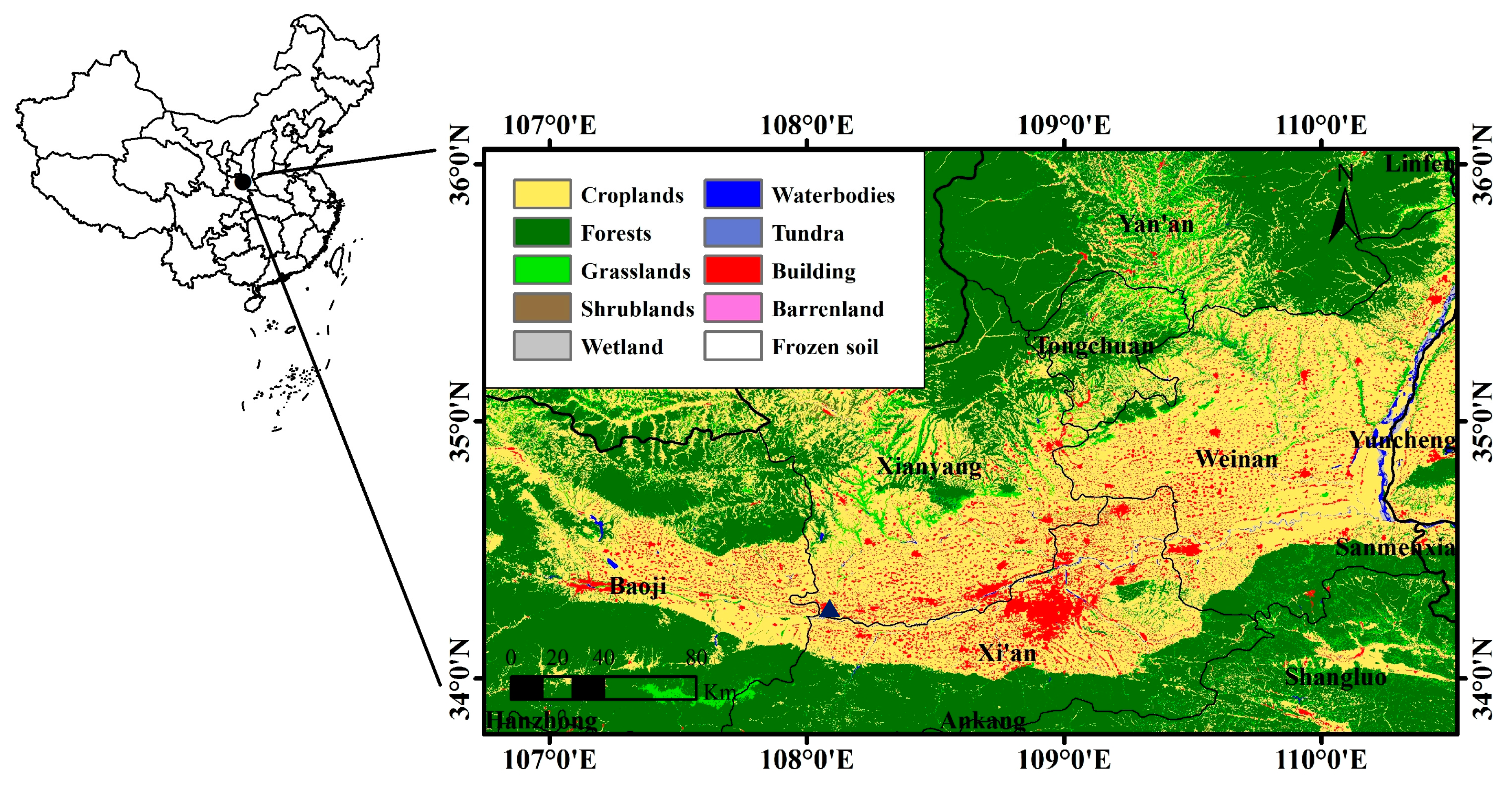


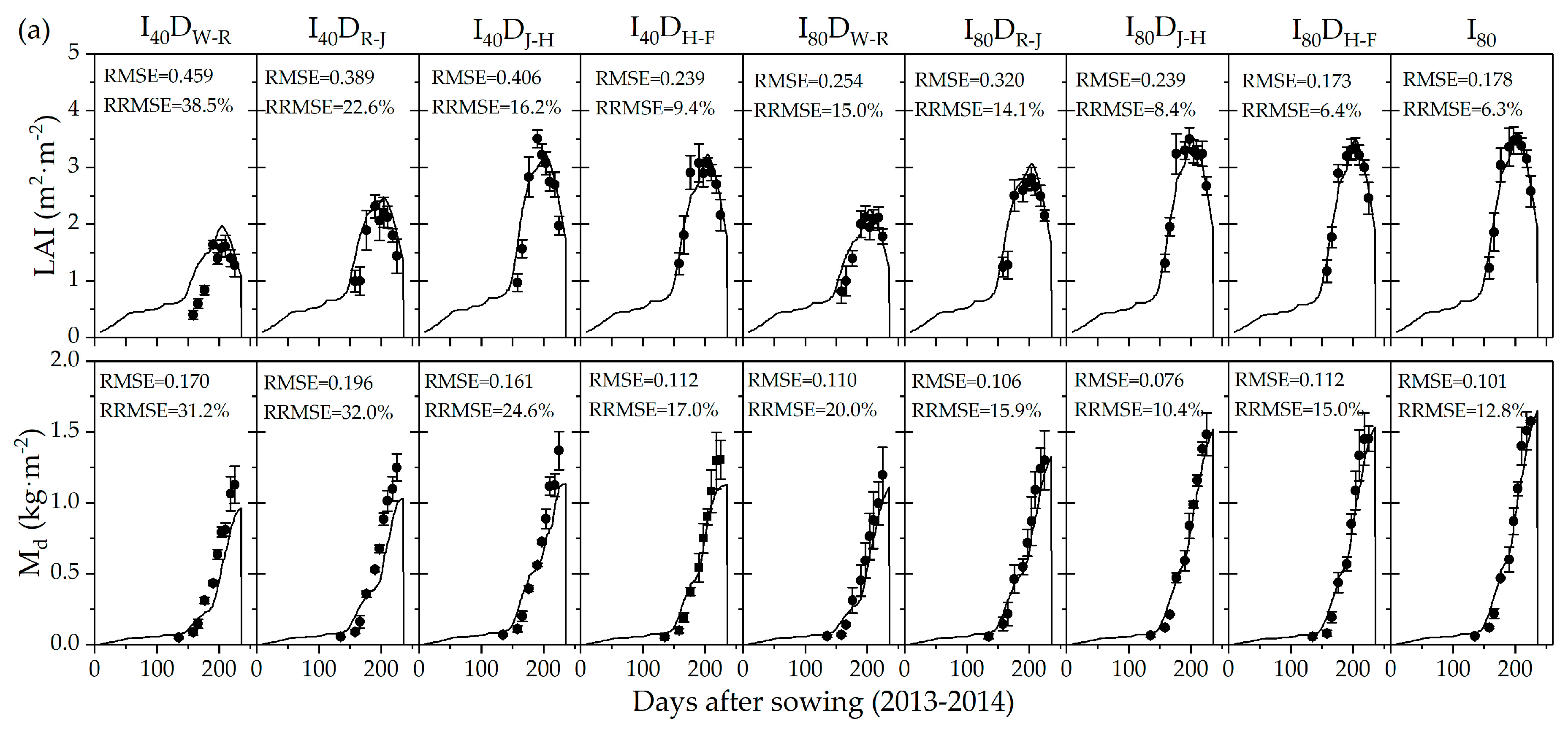


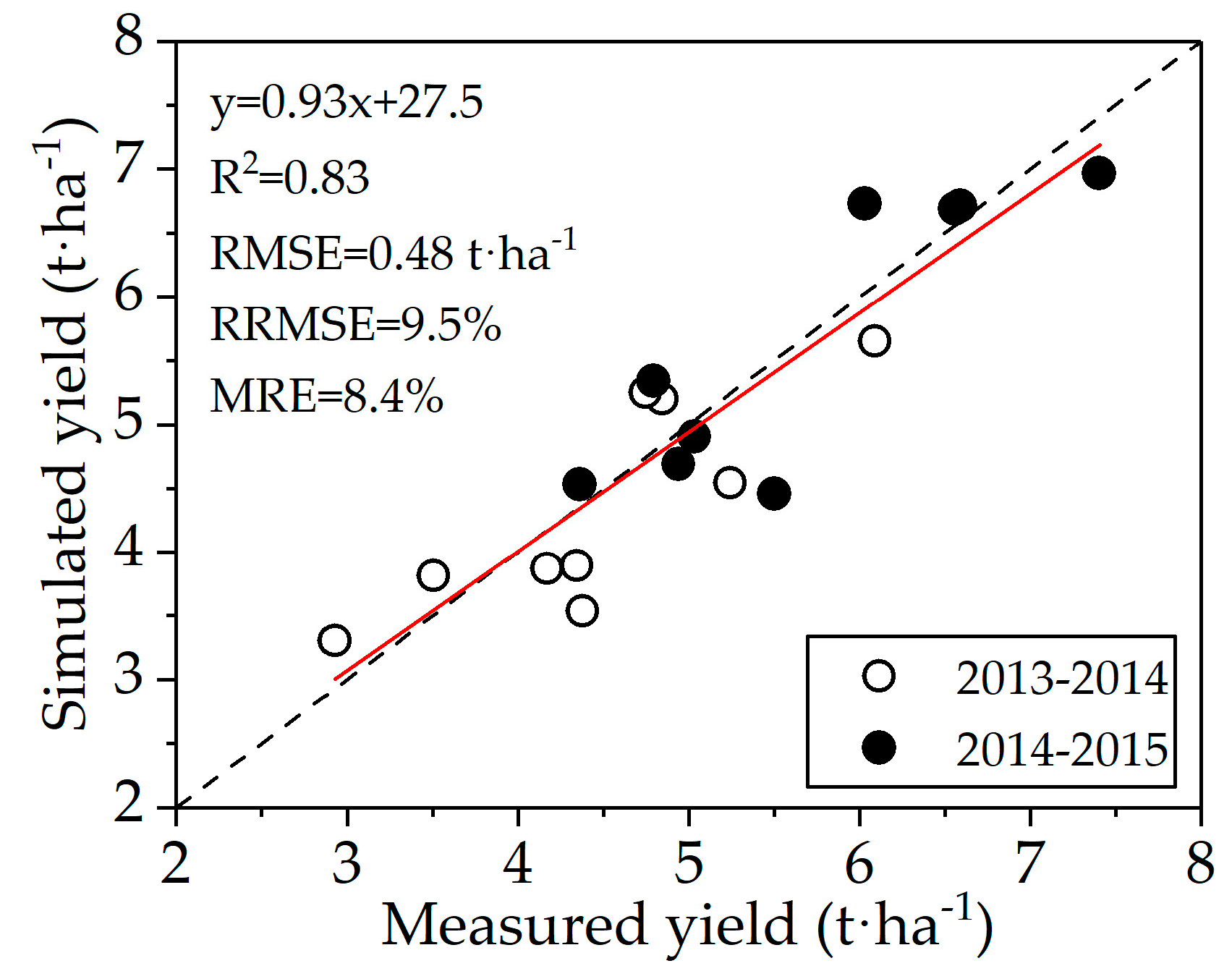
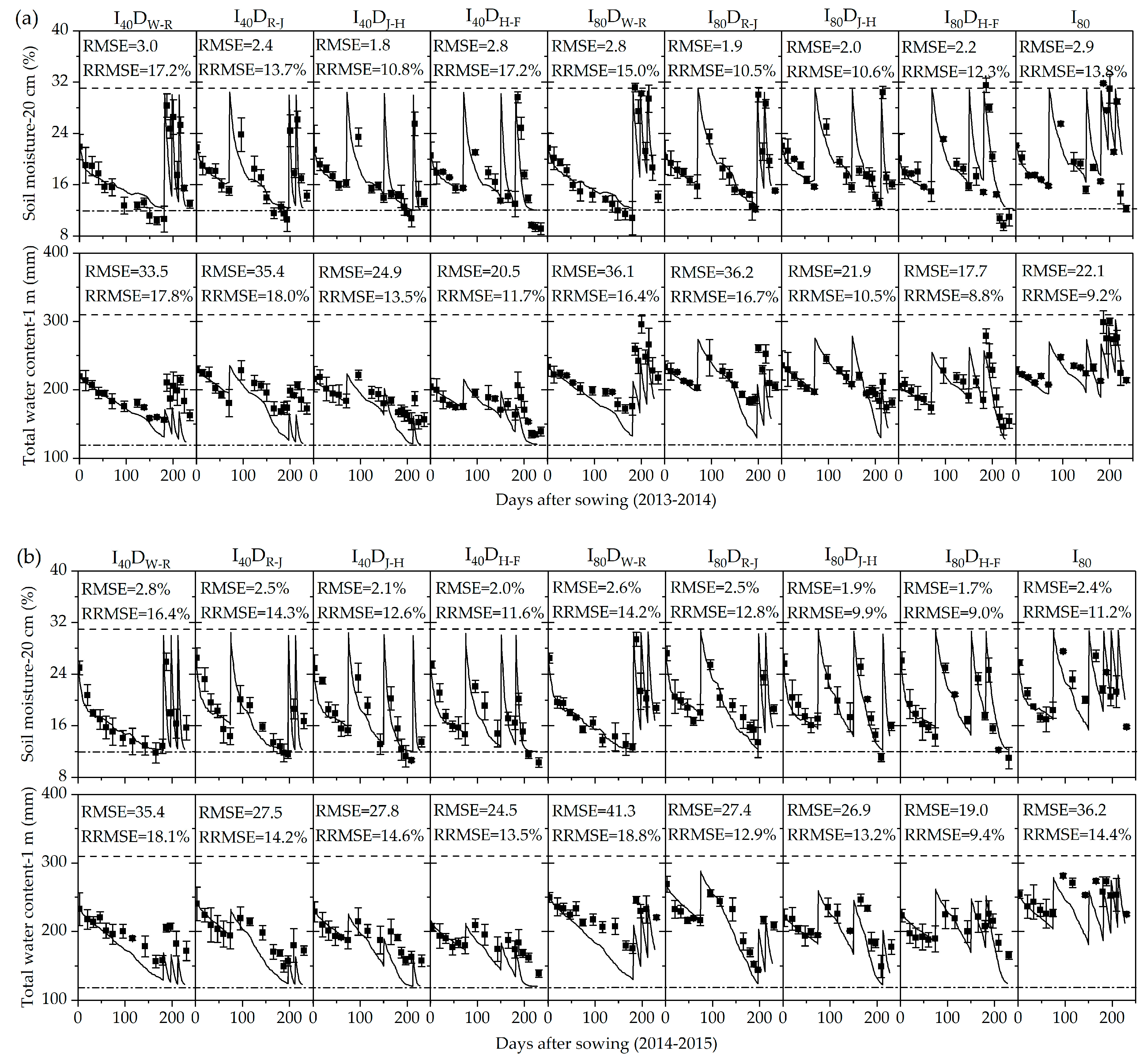
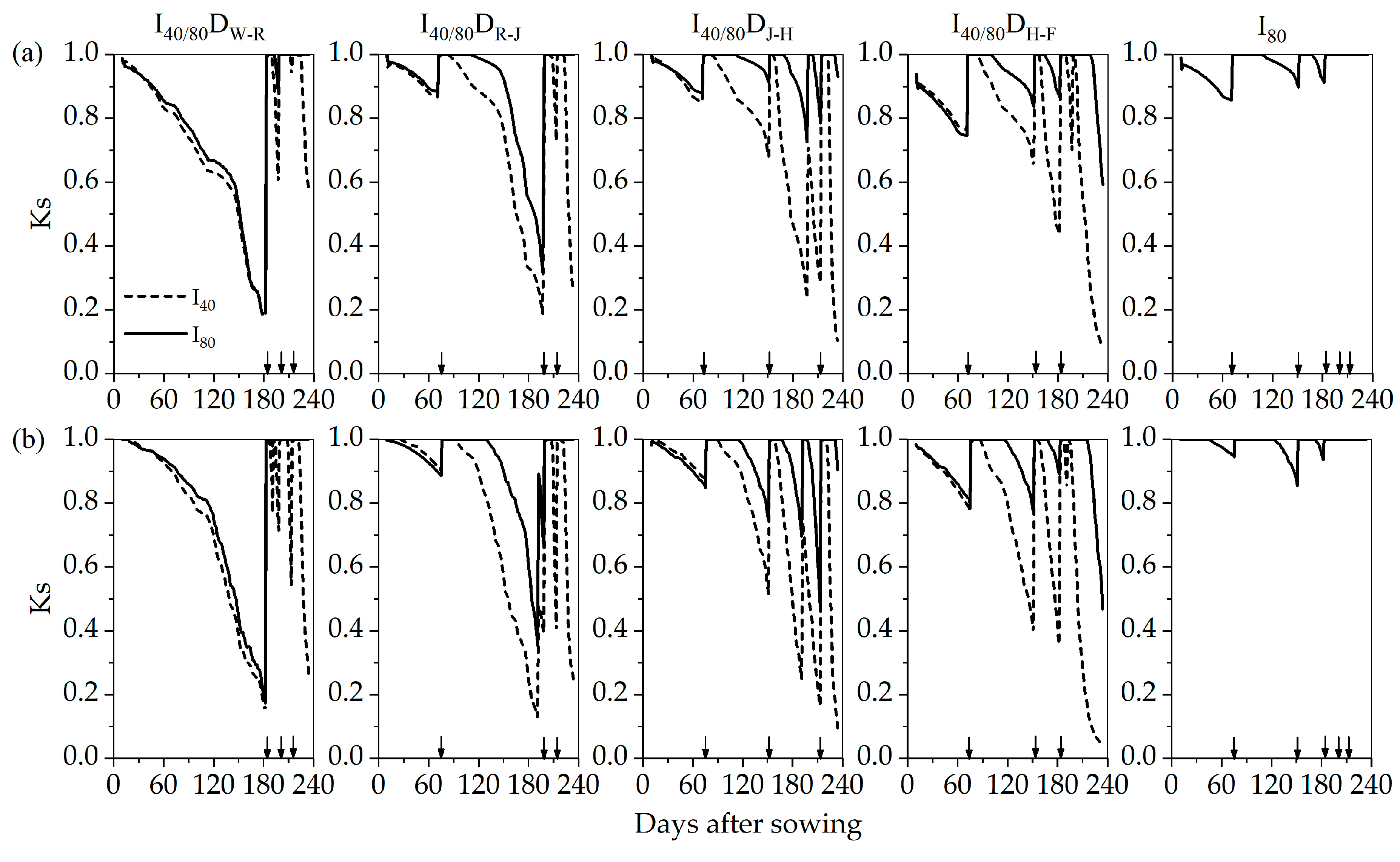
| Irrigation Schedules | Irrigation Scenarios | ||||||||
|---|---|---|---|---|---|---|---|---|---|
| I40DW-R | I40DR-J | I40DJ-H | I40DH-F | I80DW-R | I80DR-J | I80DJ-H | I80DH-F | I80 | |
| Wintering | 0 | 40 | 40 | 40 | 0 | 80 | 80 | 80 | 80 |
| Reviving | 0 | 0 | 40 | 40 | 0 | 0 | 80 | 80 | 80 |
| Jointing | 40 | 0 | 0 | 40 | 80 | 0 | 0 | 80 | 80 |
| Heading | 40 | 40 | 0 | 0 | 80 | 80 | 0 | 0 | 80 |
| Filling | 40 | 40 | 40 | 0 | 80 | 80 | 80 | 0 | 80 |
| Total amount(mm) | 120 | 120 | 120 | 120 | 240 | 240 | 240 | 240 | 400 |
| Notation | Description | Unit | Value | Sources | |
|---|---|---|---|---|---|
| Inputs | Rg | Daily incoming global radiation | MJ m−2 ∙d−1 | ||
| Ta | Daily mean air temperature | °C | |||
| P | Daily precipitation | mm | |||
| ET0 | Daily reference evapotranspiration | mm | |||
| SM0 | Initial soil moisture | m3∙m−3 | |||
| Parameters | εc | Climatic efficiency | - | 0.48 | L |
| Md0 | Initial dry aboveground biomass | g∙m−2 | 5.3 | D | |
| k | Light extinction coefficient | - | 0.53 | M | |
| Tmin,opt,max | Temperature for growth | °C | 0,18,26 | L | |
| SLA | Specific leaf area | m2∙g−1 | 0.019 | M | |
| D0 | Day of plant emergence | day | 10 | M | |
| Pla | Partition-to-leaf function: par a | - | 0.589 | C | |
| Plb | Partition-to-leaf function: par b | - | 0.00023 | C | |
| STT | Sum of temperature for senescence | °C | 963 | C | |
| Rs | Rate of senescence | °C∙d−1 | 14937 | C | |
| LUE | Light-use efficiency | g∙MJ−1 | 2.0 | L | |
| θFC | Field capacity | m3∙m−3 | 0.31 | M | |
| θWP | Wilting Point | m3∙m−3 | 0.12 | M | |
| Kcb,max | Maximum crop basal coefficient | - | 1.07 | L | |
| Ktrp | Coefficient between LAI and Kcb | - | 0.84 | L | |
| Kz | Root growth rate | m °C∙d−1 | 0.0009 | L | |
| pu,pl | thresholds of soil water depletion | - | 0.3, 0.65 | L | |
| f | Water stress function curve shape | - | 3 | L | |
| β | Evaporative reduction coefficient | - | 0.94 | L | |
| HI | Harvest index | - | 0.34 | M | |
| Outputs | LAI | Daily leaf area index | m2∙m−2 | ||
| Md | Daily dry aboveground biomass | g∙m−2 | |||
| Yield | Grain yield | g∙m−2 | |||
| SM | Daily soil moisture | m3∙m−3 | |||
| ETa | Crop evapotranspiration | mm |
| Irrigation Scenarios | 2013–2014 | 2014–2015 | ||||
|---|---|---|---|---|---|---|
| ETa (mm) | ETa (mm) | |||||
| Obs. | Sim. | RE (%) | Obs. | Sim. | RE (%) | |
| I40DW-R | 177 | 218 | 23.5 | 181 | 233 | 28.6 |
| I40DR-J | 177 | 230 | 29.6 | 188 | 243 | 29.1 |
| I40DJ-H | 179 | 215 | 20.0 | 191 | 233 | 21.8 |
| I40DH-F | 185 | 205 | 10.3 | 188 | 217 | 15.5 |
| I80DW-R | 256 | 297 | 16.0 | 263 | 316 | 19.8 |
| I80DR-J | 268 | 329 | 23.1 | 301 | 356 | 18.5 |
| I80DJ-H | 294 | 344 | 17.0 | 282 | 329 | 16.4 |
| I80DH-F | 291 | 321 | 10.3 | 298 | 349 | 17.1 |
| I80 | 414 | 421 | 1.5 | 429 | 453 | 5.5 |
© 2019 by the authors. Licensee MDPI, Basel, Switzerland. This article is an open access article distributed under the terms and conditions of the Creative Commons Attribution (CC BY) license (http://creativecommons.org/licenses/by/4.0/).
Share and Cite
Zhang, C.; Liu, J.; Dong, T.; Pattey, E.; Shang, J.; Tang, M.; Cai, H.; Saddique, Q. Coupling Hyperspectral Remote Sensing Data with a Crop Model to Study Winter Wheat Water Demand. Remote Sens. 2019, 11, 1684. https://0-doi-org.brum.beds.ac.uk/10.3390/rs11141684
Zhang C, Liu J, Dong T, Pattey E, Shang J, Tang M, Cai H, Saddique Q. Coupling Hyperspectral Remote Sensing Data with a Crop Model to Study Winter Wheat Water Demand. Remote Sensing. 2019; 11(14):1684. https://0-doi-org.brum.beds.ac.uk/10.3390/rs11141684
Chicago/Turabian StyleZhang, Chao, Jiangui Liu, Taifeng Dong, Elizabeth Pattey, Jiali Shang, Min Tang, Huanjie Cai, and Qaisar Saddique. 2019. "Coupling Hyperspectral Remote Sensing Data with a Crop Model to Study Winter Wheat Water Demand" Remote Sensing 11, no. 14: 1684. https://0-doi-org.brum.beds.ac.uk/10.3390/rs11141684



